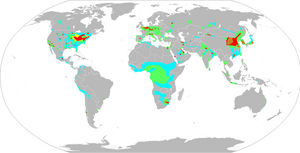
Respiratory health effects of air pollution: Update on biomass smoke and traffic pollution ( 9 page pdf, Robert J. Laumbach and Howard M. Kipen, Clinical reviews in allergy and immunology, The Journal of Allergy and Clinical Immunology, Jan, 2012)
Also discussed here: Review Hardens Links Between Air Pollution, Health Problems (Christine Hsu, Medical Daily, Dec. 26, 2011)
Today’s review article is very useful overview and updated literature review of two types of pollution that are both increasing in importance and have not been as well researched as ambient air pollution as a major health impact: the burning of carbon fuels inside homes (BMFs) in developing countries and exposure to traffic related air pollution (TRAPs) near roadways. The authors conclude by listing what is known and what is not, some of which is noted below.
Key Quotes:
“recent research has heightened the focus on 2 broad sources of air pollution: biomass fuels (BMFs) and motor vehicles. Understanding of the health effects of BMFs and traffic-related air pollution (TRAP) has lagged behind that of ambient air pollution”
“Although tobacco smoke is clearly the dominant cause of COPD worldwide, BMF smoke is now recognized as a major cause of COPD, especially among women in less-developed countries (LDCs)… The WHO has estimated that BMF smoke exposure is responsible for about 1.5 million premature deaths per year..About 2.4 billion persons live in households in which BMFs are the primary fuel for cooking, heating, or both”
“Concentrations of TRAP have steep gradients near roadways, with heightened exposure to persons living, attending school, or working near major roads in urban areas and return of TRAP to background levels within several hundred meters away from roadways…TRAP exposures are concentrated in areas of greater traffic density, which, at least in the United States, tend to be inner-city communities of lower socioeconomic status with a higher burden of environmental contamination/effects”
“non freeway pollutants demonstrated a stronger effect than those from freeways, possibly reflecting an effect of frequent acceleration and deceleration on TRAP characteristics”
“What do we know?
- It is more difficult to estimate individual exposures to BMFs and TRAP than to ambient air pollution.
- TRAP has been shown to increase the risk of COPD in well-controlled studies.
- TRAPis associated with the development of asthma in adults.
- Short-term air pollution interventions have been shown to decrease respiratory morbidity.
- How much asthma risk is actually attributable to TRAP
- A widely approved and acceptable method to reduce pollution from burning BMFs
- Effects of TRAP on respiratory outcomes beyond asthma
- How TRAP causes asthma: allergic, irritant, and/or other
- Whether neonatal exposures to TRAP actually represent a critical window to cause childhood asthma”
Related articles
- Traffic-Related Pollution Can Cause the Skin to Age (bellasugar.com)
- BBC News - Beijing releases air pollution data (djcadchina.wordpress.com)
- Air pollution increases risk of diabetes and hypertension developing in black women, researchers say (thegrio.com)
- Polluted air could put Olympic athletes at risk, warn scientists (independent.co.uk)
- Study Finds Air Pollution Linked To Diabetes And Hypertension In African-American Women (medicalnewstoday.com)
- Air pollution ups diabetes, hypertension risk in African-American women (thehindu.com)

No comments:
Post a Comment